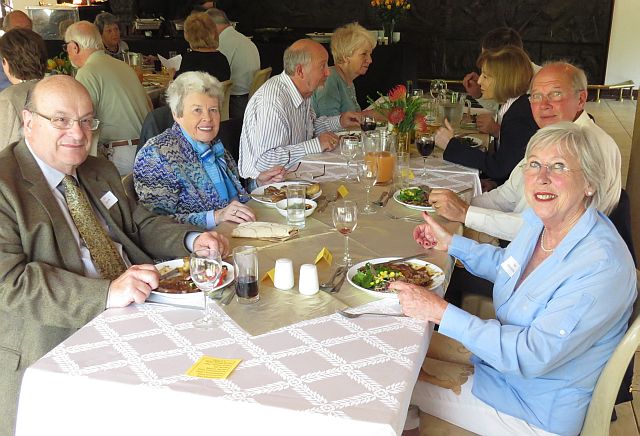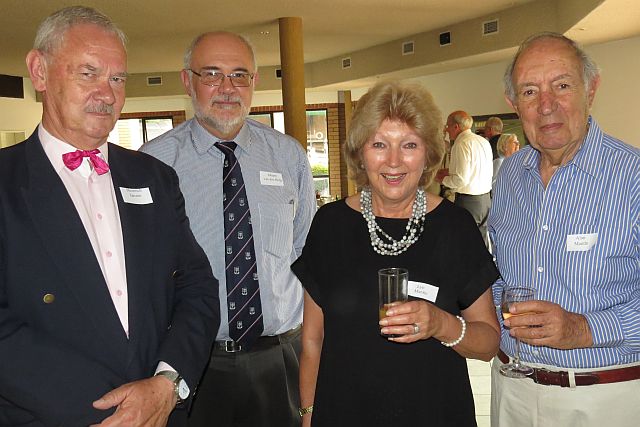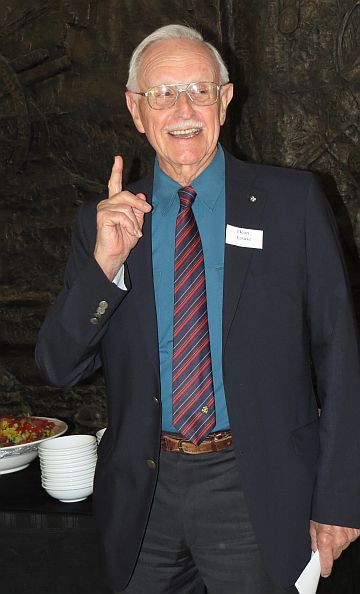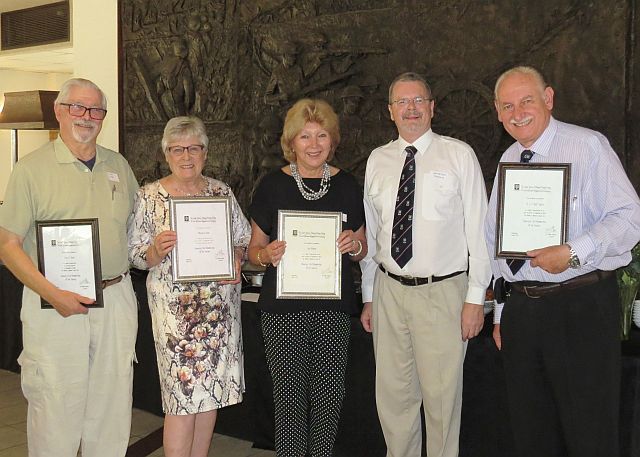

 The South African
The South African
Background and objectives
The seed of forming a military history society for southern Africa was sown by the late Neville Gomm. A former Signals instructor and military memorabilia collector, Gomm wrote to like-minded individuals in June 1966, proposing the establishment of a society. From the outset, there would be a strong association with the then South African National War Museum, under the directorship of Commandant George Duxbury. A first meeting of the Society was scheduled to take place at the museullJ on 5 October 1966. At the meeting, Commandant-General H B Klopper, retired Chief of the South African Defence Force, delivered an address in which he highlighted the challenge which the Society would face every day, namely the encouragement of the study of military history amongst the younger generation. Thereafter, Neville Gomm proposed the establishment of a military history society. A provisional committee, under the chairmanship of Don R Forsyth, met on Thursday, 20 October 1966, and a set of rules was finalized for the Society. The first general meeting took place on Thursday, 3 November, when these rules were presented to, and approved by, the members. The first lecture followed. It was by Major R J Southey, who gave a talk on Majuba. At the initial meeting, too, the provisional committee was re-elected to hold office until the first Annual General Meeting, to be held in 1967.
The Constitution of the South African Military History Society, based on the original rules, was introduced by Charles Cohen at a special general meeting held on 28 July 1969. It was adopted with the following aims and objectives:
Milestones
There have been many milestones over the years. The first scribe of the Society was Neville Gomm, who filed the post until May 1968. The first issue of the Military History Journal, Vol 1 No 1, was published by the South African National War Museum in association with the South African Military History Society in - December 1967. Following correspondence with the South African College of Heralds, the Society's logo was designed by Joan Pell. It comprises an upright roman-type sword in silver and gold, crossed by three quills with white flights, cut ready for use, symbolic of the three forces of land, sea and air and signifying the recording of history, all on a dark navy blue shield, with a scroll below inscribed 'SAMHS' (South African Military History Society) and 'SAK-HV' (Suid-Afrikaanse Krygs-Historiese Vereniging). The name, 'The South African Military History Society', was officially registered by the State Herald in 1971 and a certificate of registration issued. The first Society tie was produced in 1971, consisting of oblique narrow red and silver stripes and the Society's logo in silver and black on a blue background. The design was updated in 2000.
Battlefield tours were popular from the beginning. This continues to this day. The first tour - to Pretoria - took place on 11 June 1967. With the IT revolution, a website became essential. This was set up by Mike Marsh and can be accessed at http://www.samilitaryhistory.org. The website features a list of articles that have appeared, in the Military History Journal to date, current and past Society newsletters, contact details of various organizations dedicated to military history;and a host of other information. Social media has also become very important in getting people involved, and-caters for a new market, most notably the younger generation. Jan-Willem Hoorweg has administered the Society Facebook page for a number of years (you can find us under 'The South African Military History; Society') and to date the site has received a thousand likes. Moving ahead with new-trends, the Johannesburg Branch has started recording talks, which can now be accessed via internet streaming on SoundCloud.
From very humble beginnings, with 41 members, the - Society has grown to around 500 members in four branches throughout South Africa and including a number of overseas members.

Gil and Maeve Jacobs, Peter and Jean James-Smith, 2 obscured, Dave and Sian Drummond
The future
The goal for the future is to keep the Society sustainable in an ever-changing environment, fighting prejudices and a growing lack of interest in the past. The addition of new, younger military history enthusiasts of all races is therefore crucial and will help drive the Society to new heights.
The celebratory 50th anniversary luncheon
To celebrate this special moment in the Society's history, 47 members and guests attended an anniversary luncheon which was laid on in the Marrieres Wood Room at Ditsong National Museum of Military History in Saxonwold, Johannesburg, on Sunday, 16 October 2016. Through the efforts of Joan Marsh and the Committee, a wonderful meal was arranged - a buffet to remember for many years to come. The caterer, Katherine Bell, laid out colourful table settings with gold symbolizing the half-century. A bar service was provided. Beautiful protea flower arrangements added colour and a unique South African flavour to each table.
Current Society Chairman, Jan-Willem Hoorweg - whose late father, Flip Hoorweg, had been chairman when the fortieth anniversary had been celebrated ten years earlier - welcomed everyone in his introductory speech. Guests included Charles Cohen, former chairman and the person who had written up the Society's Constitution, Ian Uys, former chairman and auditor, who had travelled up from Knysna with his wife, Barbara, and Johan van den Berg, chairman of the Cape Town branch, and his wife, Emsie, who also graced the gathering with their presence.

Left to right: Heinrich Janzen, Johan van den Berg, and Lyn and Alan Mantle
Using this auspicious occasion, the Chairman then presented honorary life memberships to four Society stalwarts, who have collectively served the Society for almost seventy years. Certificates were awarded to:
As always, huge gratitude is due to Ditsong National Museum of Military History, which has been very supportive over this time and the Society is thankful to the Director and all staff who have given much of their time to the Society.
After the toast, Grace was observed by Bob Smith, and a . wonderful lunch ensued, with members sharing reminiscences about the years gone by and hoping for a good future.
The Fiftieth Anniversary Toast by Professor Deon Fourie

' ... What a pleasure it really is to be here to share in this wonderful celebration today. How it takes one's mind back to those activities then when the draft Constitution was circulated among us and the prospects of having a Military History Society were being discussed. You may remember that in the film, The History Boys, the young school teacher, Tom Irwin, tells the boys that memorials are raised to help people forget, not to help them remember. In a way, that might be partly true: stone and bronze memorials seldom say what they need to say to communicate their meaning to all people. They speak only to the people who already know, and perhaps not even to them.

From left to right: Colin Dean, Marjorie Dean, Lyn Mantle, Jan-Willem Hoorweg (Chairman), and Bob Smith.
Recently I have delivered lectures on the Battle of Delville Wood and it astonished me to hear how even descendants of participants in the First World War know only the name 'Delville Wood', not what it signified, nor where it was. One person who questioned me had been searching for it in maps of Namibia!'lt is because of this lack of knowledge of the past wars that I think the SAMHS can play a significant role in South Africa.
In the Constitution drafted by the dynamic Charles Cohen - one of our enthusiastic Chairmen - the principal focus of the Society was the academic goal of "the promotion of scientific study, research and' appreciation of the history of armed forces and military history and the publication of literature-on these subjects ... "
While that academic goal remains, fifty years on, the Society serves as an important living memorial that stone and bronze memorials cannot be. It has become a memorial to the people who cared enough to establish the SAMH Society - George Duxbury, Neville Gomm, Don Forsyth, Charles Cohen, and so many others. It is a memorial and a tribute to those who have cared enough to keep the Society alive for fifty years, labouring for us in various places - to those on the governing committee (especially the office holders who have chaired the Society or administered the Society's finances and membership, programmed the meetings, found speakers, arranged tours to various parts of the country, the secretaries and treasurers) and, of course, to those who were our speakers, and to our ordinary members whose support gives life to the Society.
On our memorial, we trace the names of so many and I can only mention examples: The indefatigable Joan Marsh and Mike, Ian Uys, Felix Machanik, Hamish Paterson, John Keene, Marjorie and Colin Dean, Darrell Hall and his dramatic slide shows, Philip Gon, Ivor Little, John Mahncke, and Ossie Baker, Johan Barnard, Ian Copley and Jenny Copley, the first woman Chairman, and Lyn Miller (now Mantle), the second woman in the Chair, Bob Smith, Tony Speir, Maurice Gough-Palmer and Flip Hoorweg, whose son, Jan-Willem, now carries the banner previously borne by his father. These people are among the many who have been the spirit giving life to our memorial.
A keystone without which the memorial might be hard put to stand is the Journal, founded within a year of the Society's birth. The older it gets the more stimulating and exciting it becomes. It teaches us about events of which we knew nothing, about courage, military fools and military genius, and it is published for the benefit of all South Africans to read. I wish the journal could be bought at the CNA. The editors have been extraordinary people - and we recall with pride John Ball, Doug Tidy, Helen Hansmeyer, Rochelle Keene, Karin Greyvenstein, Margaret Northey, Nick Kinsey, Stan Monick, and so on, and it continues to thrive under the firm hand of Susanne Blendulf.
But the South African Military History Society is also a memorial to the events that make military history, to the wars of the past not just those in our recent past but all those that made up history, from the Wars of the Roses to the present day. All that is published, all that is lectured on, makes it sure that this memorial does not allow us to forget. As a memorial to the events of military history the Society inevitably is a memorial to those people who participated in wars - those who returned and those who lie far from their homes, "in some foreign field", who surrendered their lives when their, governments or leaders called them to repair the blunders of politics ... The people of whom Kipling thought when he wrote: "If any question why we died, tell them, because our fathers lied."
Our Society's roles have been to be vital, to speak, to stimulate, to inform and to ensure that we remember. It has done so much and still has so much to do. I believe it has made us the better South Africans. It still has much to do to inform all South Africans, objectively, about South African military history and the South Africans who made that history. It stands as a proud memorial not least as a monument to its own. I ask you to remember all these achievements, to carry on in the same vein and better ... and to remember the meaning of this special memorial ... as you stand ... to toast the South African Military History Society, its great past ... and its great future. Ladies and Gentlemen ... the South African Military History Society!'
Return to Journal Index OR Society's Home page
South African Military History Society / scribe@samilitaryhistory.org